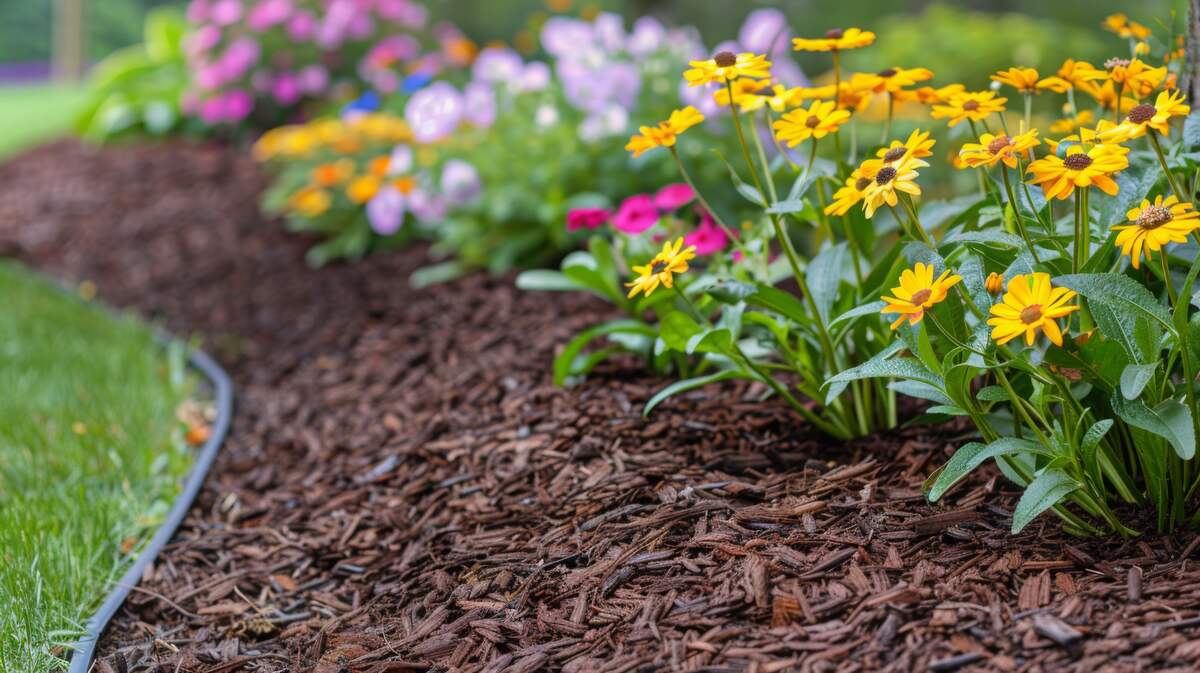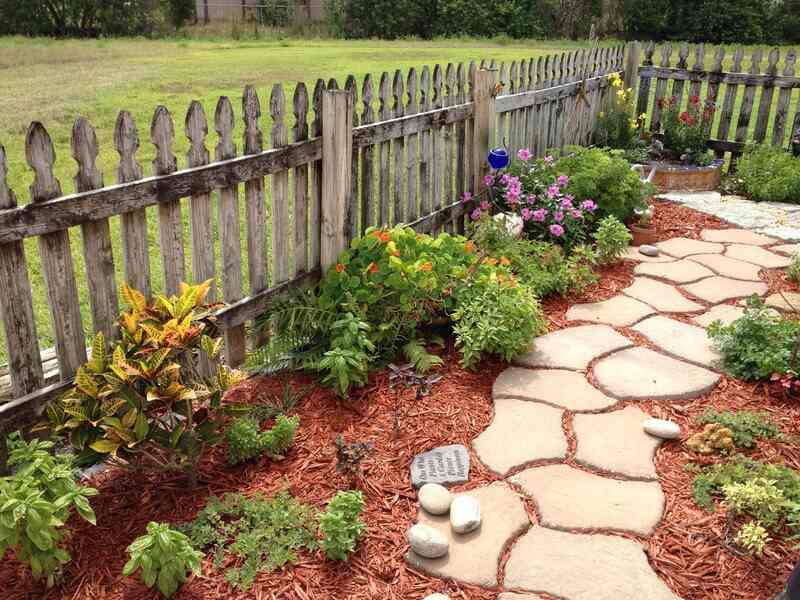
Not only does mulch help improve the health of lawns and gardens, but it can also add aesthetic appeal. And to maximize its design element, remember to choose the right mulch color.
However, figuring out which mulch colors work well with your property can be challenging. So, we’ll go over the three most common color options — black, brown, and red — and the various factors you must consider to help you choose the best color mulch for your landscape.
For a quick recommendation, check out our mulch color calculator below.
Mulch Colors
Much like your turfgrass, mulch can also influence your yard’s overall look. So, you’ll want to consider all factors before deciding what color mulch to use for your landscape.
You’ll find many different colors of mulch to choose from, but most homeowners choose to go with these three colors:
Black Mulch

If you want to give your landscape a contemporary yet striking look, you might want to choose black mulch — available in dyed wood chips, bark, and rubber mulch. The bold contrast will help make green foliage and brightly colored flowers stand out.
Visual Impact: Modern, dramatic
Heat Absorption: High
Fade Rate: Fast
Home Colors: White, gray, pastel
Plant Colors: Any – makes colors pop
Best Used On: Flower beds with bright blooms
Architectural Style: Contemporary
Other Considerations:
- Adds depth and richness, even to plants in shaded areas
- Creates a sleek and polished look, making flower beds pop and look well-maintained
- Helps warm up the soil, benefiting heat-loving plants like hibiscus, yarrow, and cosmos
- Perfect for minimalist landscape designs
- Dries out the soil faster in hot climates
- Fades faster than other colors
Note: If you live in a warm region but still want to use black mulch, consult a local landscaping pro first. They can help you determine which type of mulch is best for your landscape.
Brown Mulch

The most natural-looking color option, brown mulch has an earthy tone that creates an inviting look that blends well with most landscapes. It’s available in organic mulch types like compost, bark, wood chips, and pine needles. If you’d rather use inorganic mulch, you can find rubber mulch, pea gravel, and pebbles in brown.
When comparing black mulch vs. brown mulch, the latter retains its color longer because the colorant used is more resistant to sunlight exposure and weathering.
Visual Impact: Natural, subtle
Heat Absorption: Low to moderate
Fade Rate: Slow
Home Colors: Earthy tones, such as beige, brick red, or tan
Plant Colors: Any – serves as a neutral backdrop
Best Used On: Raised garden beds and around trees and shrubs
Architectural Style: Traditional
Other Considerations:
- Adds a cohesive and natural look
- Creates a warm, inviting feel to outdoor spaces
- Some options, like cedar and cypress, offer natural pest resistance
- Helps plants and flowers stand out without overpowering the space
- Mimics the look of forest floors, making it the colored mulch of choice for homeowners who want to create traditional or rustic landscapes
- Less dramatic color than black or red
- Most versatile color option in any climate
Red Mulch

If you want to give your landscape a lively and vibrant appearance, red mulch is a good option. Typically available in the form of dyed wood chips or rubber mulch, it also offers contrast. When comparing black mulch vs. red mulch, some people find the latter unnatural and tacky. Still, red mulch is a good option for specific styles of homes.
Visual Impact: Intense, energetic
Heat Absorption: High
Fade Rate: Moderate to fast
Home Colors: Yellow, brown, tan, beige
Plant Colors: White, yellow, and blue
Best Used On: Decorative beds, driveways, pathways
Architectural Style: Mediterranean or Southwestern homes
Other Considerations:
- Gives an intense and vibrant feel
- Works well in tropical, desert-style, or drought-tolerant landscapes
- Complements warm-colored homes, such as those made from brick, stucco, or adobe
- Creates a striking contrast with dark green foliage
- Can clash with pink, orange, and purple flowers
- Fades over time to a rusty brown shade
Factors to Consider When Choosing Mulch Color
Find the Perfect Mulch Color for Your Landscape
Your Landscape Profile
Your Mulch Recommendation
Top Recommendation Details
Best For:
Select your landscape profile, then click the “Find my Ideal Mulch Color” button.
The best color mulch is one that balances aesthetics and functionality, ensuring it complements your landscape while also supporting plant health. Here are some key points to consider when deciding what color mulch looks best:
Your Landscape Style
Choose a mulch color that complements your landscape style. For instance, black mulch suits modern and minimalist styles, while both brown and red work well in more rustic or traditional settings.
| Landscape Style | Black Mulch | Brown Mulch | Red Mulch |
| Modern | ✔ | ||
| Traditional | ✔ | ✔ | |
| Mediterranean | ✔ | ✔ | |
| Formal | ✔ | ||
| Cottage garden | ✔ | ||
| Minimalist | ✔ | ||
| Rustic | ✔ | ✔ |
See Related: How to Improve Your Lawn With Mulch
Your Home’s Exterior Color
Match your mulch color to your home’s exterior tones to create a more cohesive look. For gray or white homes, black mulch is the way to go. Brown works well with earth tones, while red matches warm-colored exteriors like brick or stucco.
Your Plants
Choose a mulch color that helps further bring out the color of your plants. Black mulch provides a good contrast for bright green and colorful blooms, while brown creates a natural backdrop that blends well with most plants. To create a striking contrast with dark green foliage and make yellow, white, and blue flowers pop, you’ll want to use red mulch instead.
See Related:
Light Conditions
Black mulch can add depth and definition to plants in shaded areas, making them feel more structured. Plants that sit under the bright sunlight most of the time will benefit from brown or red mulch to balance the glare and create a softer feel.
Regional Considerations
In northern climates, black mulch, or any other dark-colored mulch, is a good choice because it helps retain warmth. On the other hand, those living in hotter or desert regions should go with brown or red, which reflects heat and keeps the soil cooler. If you live in a coastal or desert area, you may also benefit from light-colored mulches.
| Region | Climate Characteristics | Recommended Mulch Colors |
| Northern U.S. | Cold winters | Black, red |
| Southern U.S. | Hot summers | Brown, red |
| Coastal Areas | High humidity, salt exposure | Brown |
| Desert | Extreme heat | Brown |
Longevity and Fading
With black mulch absorbing more UV rays from the sun, its dye breaks down faster than those of lighter-colored materials. In addition, its heat retention capability leads to faster decomposition and color fading. The same goes for other dark-colored mulches, including dark brown and deep red mulches.
- Black mulch: Fades to gray within 6 to 12 months
- Brown mulch: Slowly fades within 1 to 2 years
- Red mulch: Fades to rusty brown within 8 to 14 months
Pro Tip: Since replacing mulch often can be costly, you can use mulch dye to give your colored mulch a fresh look once it fades. A quart (32 fl. oz.) of mulch dye that costs around $23 can restore the color of up to 14,400 square feet of mulch.
Environmental Considerations
If being eco-friendly is one of your priorities, then using natural, untreated mulch is the way to go. These mulches, such as stones, pebbles, and wood chips, can also come in different colors, but the trade-off is that the color choices are not as varied as dyed mulches.
Cost
On average, mulch costs anywhere from $20 to $400 per cubic yard, with colored mulch being more expensive than natural-colored mulch. This is due to the additional dyeing process and the cost of the colorants. The type and concentration of dye can affect the final cost, with blue being the highest, and the natural brown mulch being the most affordable.
See Related:
FAQ About Choosing the Right Color Mulch
Yes, you can mix different color mulches in your landscape design. For instance, placing black and brown mulch adjacent to each other can create a natural look while highlighting specific plants or borders. However, avoid using too many colors as it could make your landscape look messy.
Yes, it’s OK to refresh only parts of your mulched area. But if there’s a significant difference in color, you may want to remove or dye the old mulch to match the new.
Rubber and plastic mulches come in many different shades, such as blue, green, black, silver, and brown, and they also tend to hold their color longer. If you want to go organic, dyed wood chips and shredded bark are available in various colors like black, brown, red, and even gold. Cedar and pine also offer subtle color variations.
Yes, mulch color can impact curb appeal and increase home value. That’s why you must choose a color that complements your home and plants. Doing so creates a polished and well-maintained look, as it ties together your home’s exterior and landscaping.
Transform Your Landscape With the Right Mulch Color
The best color mulch is one that elevates your landscape’s curb appeal without compromising your soil’s health. Choosing from different colors of mulch is just one of the many steps in maintaining a lawn. If you’re not sure what color mulch looks best on your landscape, have a local landscaping pro handle the job.
Sources:
- “Garden Mulch: A Rainbow of Options.” By Allison Kosto, extension agent. Montana State University.
- “Is Colored Mulch Bad for the Environment?” By Sheila Dunning, extension agent. University of Florida IFAS Extension.
- “Mulch – A Survey of Available Options.” By Diane Diffenderfer, former master gardener coordinator. Pennsylvania State University.
- “Mulch: Using Colored Plastic Mulches in the Vegetable Garden.” University of Massachusetts Extension.
- “Mulches for Vegetable Gardens.” By Steve Reiners, former extension specialist, and Peter Nitzsche, agriculture and natural resources agent. Rutgers University – New Jersey Agricultural Experiment Station.
Main Photo Credit: Prostock-studio / Adobe Stock Generated by AI